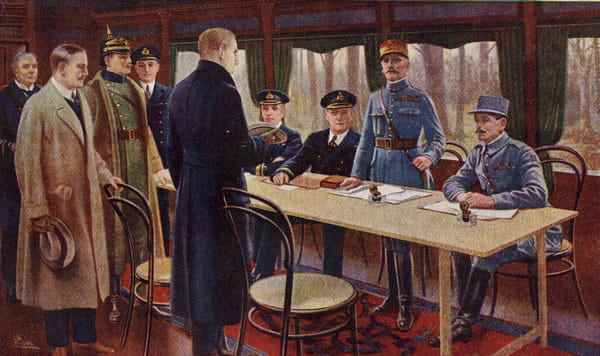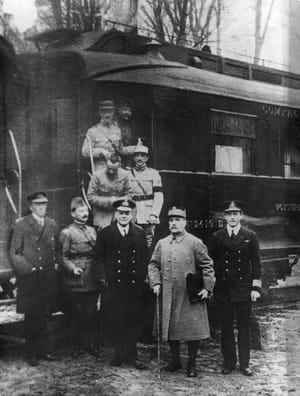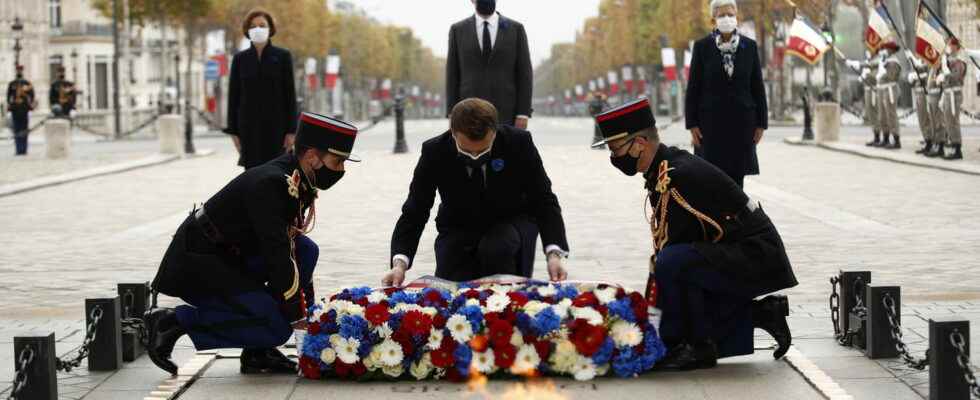STORY. Every November 11, the 1918 armistice is commemorated throughout France. What exactly does this holiday honor? Definition, signature, wagon, commemoration… The Internet user takes stock.
[Mis à jour le 9 novembre 2022 à 17h18] This Friday, November 11, France commemorates the Armistice of 1918. It marks the end of the First World War. To understand why this important date in French history is commemorated, you have to go back more than a century, to Rethondes, in the Wagon de l’Armistice, the place where it was signed.
The idea of paying homage to soldiers who died during the First World War appeared in France in 1920. A law to this effect was passed unanimously in the National Assembly. We decide to choose the remains of a unknown Soldier of the citadel of Verdun and to bury him under the Arc de Triomphe. The eternal flame (or flame of remembrance) was lit for the first time in 1923 by André Maginot, Minister of War at the time. This is the first November 11 ceremony as we know it. It was in 1922 that a law was passed to make November 11 a public holiday. Since 2012, November 11 no longer commemorates only the hairy and thearmistice of 1918 but all the soldiers”died for France“, like the Memorial Day American. November 11, 1918 is also celebrated in many other countries. We can cite in particular the Remembrance Day Where Poppy Day in Commonwealth countries, where tradition requires wearing a poppy. On November 11, 2018, on the occasion of the armistice centenarysome fifty Heads of State gathered in Paris for the ceremony.
On November 11, 1918, after four years of war that left Europe bloodless, the clearing of Rethondes, in the forest of Compiègne, witnessed a historic moment. Installed in a restaurant car, fitted out inside Marshal Foch’s staff train, Germany signs a treaty in favor of the Triple Entente (composed of France, Great Britain and the United States), to end the fighting on the Western Front. This treaty also aims to define the conditions of Germany’s defeat, whose allies stopped fighting some time earlier. Bulgaria signed the cessation of fighting on September 29, theOttoman Empire on October 30 and Austria-Hungary on November 3. The November 11 armistice is therefore the last treaty, signed after four days of negotiations.
In this car, the Triple Entente is represented by Marshal Ferdinand Foch and Germany by the politician Matthias Erzberger, both accompanied by their generals. What they signed on November 11, 1918, was not the capitulation of Germany strictly speaking, but a suspension of hostilities for a period of 33 days renewable. If a ceasefire is therefore officially proclaimed at 11 a.m. that day, the end of the war will only be ratified with a series of peace treaties, the most famous of which remains the Treaty of Versailles, signed on June 28, 1919. The First World War is officially over, after causing 15 to 20 million deaths, invalids and mutilations, including 8 million civilians, and reshuffling the territorial maps of the Old Continent. After the 1918 Armistice, the number of war memorials erected numbered in the thousands, and the expression “La Der des Ders” was used to express the need for this conflict to never happen again.
To begin with, “armistice” is a masculine word: we do say “un” armistice. This word comes from the Latin armed (weapon) and station (state of immobility) according to Larousse. This is’a convention by which belligerents in a war suspend hostilities. The definition of armistice implies an important nuance: this contract is concluded by the supreme military commanders and not by representatives of civil society; it does not put an end to the state of war itself, only to hostilities, hence the term which is increasingly replacing “armistice” nowadays, that of “ceasefire”, to designate this same type of agreement.
What if you had to explain it in one sentence? “Convention established between the belligerents in order to suspend hostilities, without however ending the war”, proposes the Linternaute.com dictionary.
Signed on November 11, 1918, at 5:15 a.m., in a wagon requisitioned by the French army, transformed into the command office of the head of the Allied armies Ferdinand Foch and stationed in the clearing of Rethondes in the forest of Compiègne, the armistice takes effect on the forehead at 11 a.m.… for a period of 36 days renewed three times. It is signed by the hand of the German plenipotentiaries. The latter are diplomatic agents of Germany to whom their country has entrusted full powers. At this time of the war, Emperor William II had just abdicated and gone into exile in the Netherlands. The chancellor, Max of Baden, resigned and handed over his powers to the socialist Friedrich Ebert. From there, there is no escape for Germany, whose Minister of State is expressly instructed to sign the armistice as soon as possible. The armistice of 1918 is, however, not a capitulation as such. It was indeed signed pending a definitive peace treaty.
- For the allied party, the signatories are : Marshal Foch, supreme commander of the allied forces; Admiral Wemyss, British representative; General Weygand, Chief of Staff of Marshal Foch.
- And on the German side: the plenipotentiary representative is a civilian. This is Mathias Erzberger, representative of the German government.

Many adventures preceded the famous armistice of November 11, 1918. During the summer of 1918, the Treaty of Brest-Litovsk enabled Germany, by causing the surrender of Russia, to concentrate its army on the front of the ‘West. But the German offensives of June and July 1918 were a failure and the reinforcement of the allies (Americans and British) will be fatal to him. In August 1918, a Franco-British offensive began which would not stop. In his memoirs, Erich Ludendorff, then general-in-chief of the German armies, speaks of the date of August 8 as a “day of mourning for the German army”: he knows at that moment that the war is lost for good. The retreat of the German forces then began, with heavy losses on the entire Franco-Belgian front. In September, the German General Staff informed Emperor William II that there was no longer any hope of winning the war. But the latter, as well as the military leaders, are not ready to assume defeat: it will take another two months for the armistice to be “negotiated” and signed.
From the beginning of autumn, the armistices of the eastern fronts (September 29, 1918 for Bulgaria; October 30, 1918 for the Ottoman Empire and November 3 for Austria-Hungary), although less known than that of November 11 in Rethondes, will have serious consequences. They contribute to the defeat of Germany and cause the fall of three empires. Not to mention the discord they create between defeated, victorious nations (such as the Czechs, Serbs, Romanians, Poles) and those who, having rallied too late to the victors, do not benefit from independence (Ukrainians, Slovaks… ). The eastern armistices anyway create a “breach” that Germany will not be able to close. In October, Ludendorff resigns and mutinies break out across the Rhine. At the same time, US President Wilson is responsible for taking charge of the return to peace, in the same vein as the 14 points he proposed in January in a shock speech. Notes are exchanged with the Germans on the terms.
On November 5, an official request for an armistice from the German general staff reached France in the form of a Morse code. The historic date is finally set six days later. The end of the war will be recorded in a wagon parked not far from the front and the Allied headquarters.

On November 11, 1918, the text was signed in the “Wagon de l’Armistice”, or more exactly the “car 2419D” of the Compagnie des wagons beds. This railway car, requisitioned by the army in September 1918 and transformed into an office, was parked in an isolated place but nevertheless not too far from Rethondes station: a clearing in the forest of Compiègne (Oise). Journalists are then carefully kept away. Marshal Foch, Generalissimo of the Allied armies, and General Weygand, received a German delegation there sent by the very recent Weimar Republic. Opposite, another train is used to welcome Germanic “guests”. In other words, the German parliamentarians who come to implore an armistice. According to General Weygand, Chief of Staff of Marshal Foch who had chosen the place: “Many times during the war, he had established his command post in his train. It was at his command post that the parliamentarians would therefore come to present themselves to him. The solitude of the place will ensure calm, silence, isolation, respect for the adversary…”.
The 1918 Armistice will therefore be signed inside the dining car of the French train, the famous command car of Marshal Foch. The vehicle will then be turned into a museum. Destroyed during the bombardments of 1944-1945 (adolf hitler transported it to Berlin in the meantime and even had France sign the capitulation there!), a replica was created, now installed in Compiègne Armistice Museum : this is car 2439D, which was part of the same series as the original, identically refurbished and furnished with the original furniture. As for the clearing of the Armistice, it was fitted out as a symbol of peace, accessible to the public… and this from 1922. The architect Mages designed a vast roundabout there, 100 meters in diameter, to which a 250 m long driveway. A statue of Marshal Foch is also erected there, the “monument aux Alsaciens-Lorraines” (by Edgar Brandt) – which commemorates the recovery by France of Alsace and Lorraine in 1919 -, granite slabs symbolizing the French wagon and the German wagon facing it, and an Armistice Museum built in 1922. Totally destroyed by the Germans during the Second World Warthe said museum will be reconstituted in 1950.
The conditions of the 1918 armistice imposed on Germany are without concession:
- the surrender of a large part of its armament as well as its transport equipment,
- evacuation of all occupied territories (including Alsace-Lorraine) and the left bank of the Rhine,
- demilitarization, on the right bank of the Rhine, of a zone of 10 kilometers which goes from the Dutch border to the Swiss border. This allows the Allies to keep three “bridgeheads”, Mainz, Koblenz and Cologne (the main crossing points of the Rhine) to prevent a resumption of the fight by Germany.
The armistice of 1918 putting an end to hostilities, it was still necessary to put an end to the war. The signing of the Treaty of Versailles takes place on June 28, 1919… in Versailles. He strongly condemns Germany. “Diktat” will be the term used to designate this Treaty imposed on the Germans without negotiations by the victors of the First World War. This treaty ending the First World War is signed in the Hall of Mirrors at the Palace of Versailles, between Germany and the Allies. It was prepared by the winners, the Frenchman Clemenceau, the Briton Lloyd George, the Italian Orlando and the American Wilson. In particular, it imposes on Germany the restitution of Alsace-Lorraine, the creation of the “Dantzig corridor” giving Poland access to the sea, the limitation of military potential and the payment of 20 billion gold marks. In Germany, this “diktat” will therefore be experienced as a humiliation and will give rise to a feeling of revenge.
